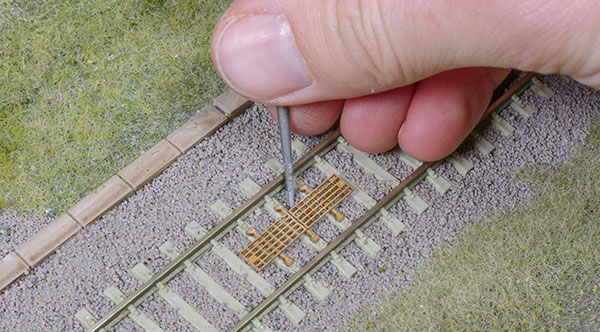Every model railway that’s to operate, regardless of its size, complexity, scale or era, requires track. It’s the first thing many of us lay on our empty baseboards, rushing the – somewhat repetitive, though others say therapeutic – challenge of ballasting, to begin rewarding scenic work.
Many a layout is only as strong as its weakest element, be it a backscene, building, the running qualities of its locomotives, and, often an afterthought, its track. Once laid, and trains run, few modellers give this vital subject a second glance, bar the odd clean with a track rubber, yet it’s here that greater realism can be achieved on a model, with little expense.
Track has many colours to it, influenced by the type of ballast – or even ash cinders – on which it was laid, to its age, the type of traffic and motive power it sees, its small details, the frequency of trains, even the climate to which it’s exposed. Hence asking the question “What colour should I paint my track?”, seems appropriate.
Photographic evidence is key. The post-1950s modeller has it easy (assuming the location isn’t niche), with books, magazine articles, and online resources such as Google Images or Flickr – to name a few – providing a wealth of knowledge. However, modellers of earlier periods might need to reference the grainy images of postcards to create a more impressionistic view of their scene.
I’m sharing a few techniques suitable for present-day modellers, which are easily achieved. Weathering track requires patience, however. It can just as easily enhance its realism as it can ruin the effect, if rushed.
Shopping List
Humbrol
(AV0210) Rust Enamel Wash
(42) Matt Enamel
(24) Matt Enamel
Coloro (00) paint brush
www.humbrol.com
DCC Concepts
Track Rust Weathering Powder
Rich Rust Weathering Powder
www.dccconcepts.com
Howes Models
Railmatch (402) Frame Dirt
Railmatch (416) Brake Dust
www.howesmodels.co.uk
Lifecolor
Surfaces Shadower
www.airbrushes.com
Content continues after advertisements
Locating TPWS on a layout
![]()
This diagram explains the locations for TPWS grid transmitters on the railway, commonly nicknamed ‘toast racks’ because of their appearance. Distances can be shortened for compromise on a layout, but the distance between transmitters will vary according to line speed and the section being protected. Transmitters used on an overspeed system in a station, for instance, will be closer together than on a main line.
1
This small diorama is an ideal test candidate for improving the appearance of the track. Unpainted plastic sleepers, clean ballast and a quick paint of the concrete trunking was fine for the original article, but let’s take this a step further.
2
A feature of modern track is the Train Protection Warning System (TPWS). Scale Model Scenery’s (LX348-OO) is a laser-cut kit for the standard grids that can be cut using a scalpel and quickly assembled. TPWS mini-grids (LX349-OO) for stations are also available from the manufacturer.
3
Observing photographs, two of the racks are glued back-to-back, following prototype practice where a line is subject to a speed limit. Locations and applications of these vary, so if in doubt, check. Roket Hot adhesive by Deluxe Materials is used.
4
Observing photographs, cables are required, fed through orange cable runs between the concrete lineside trunking and the transmitters. A small amount of ballast is removed using the tip of a needle file, to create a small channel.
5
First, I paint the rail sides a rust colour. Nothing belies the nickel silver of the track quite like its bright sheen. I use an equal mixture of enamel paints – Railmatch (402) Frame Dirt and Humbrol Rust Wash.
6
Cable trunking (scraps of 0.8mm malleable brass wire) is painted using a combination of Humbrol (15) Matt, Railmatch (204) Rail Red and DCC Concepts White Weathering powder. The powder creates a dense, faster-drying paint. The plastic from a small packet of screws makes an ideal mixing palette!
7
The cable trunking is installed, though ensure it doesn’t create a short circuit! With the painted rail sides now dry, DCC Concepts’ Rich Rust and Track Rust weathering powders are applied using a small brush. The lids for these containers serve as excellent palettes. Knock excess powder off the brush before applying to prevent overspill on the ballast.
8
Pandrol clips are highlighted with Humbrol Matt (42), while a yellow-painted marker sleeper is painted Humbrol Matt (99).
9
A piece of ‘used’ rail is glued lineside. Though merely a scenic item on the layout, it’s a piece of track nonetheless, and a common lineside feature on the modern railway. The same painting and weathering powder techniques are used.
10
Lifecolor (LC-LPW17) Surfaces Shadower is used neat through my airbrush. Its purpose is to scale down and harmonise the vibrancy of the paints applied, dirty the ballast, sleepers and concrete trunking. Apply subtly and under good lighting conditions, cleaning the rail head afterwards.
11
Track can occasionally have random spray-painted markers, either on the ballast, or sleepers. This can be to indicate a number of permanent-way related duties, or tasks to be performed. A white crayon is used to create a faded arrow, yellow paint creates a fresh appearance.
12
Litter is commonplace on the railway, particularly areas that are neglected, adjacent to roads. It will only accumulate on the permanent way where trains pass at low speed. However, the air turbulence of high-speed trains blows anything light out of sight. These simple techniques will add instant interest to your modern permanent way.
More information
If you enjoyed this practical feature, you'll find a whole host of great practical advice and step-by-step guides in our Techniques section here.
Related articles
Wiring a crossover
Wiring or tracklaying first?
How do I pin track down?
How to expand your train set
Your weekly World of Railways newsletter
Are you subscribed to our weekly email newsletter? Don't miss the latest news, reviews, modelling advice and competitions.














